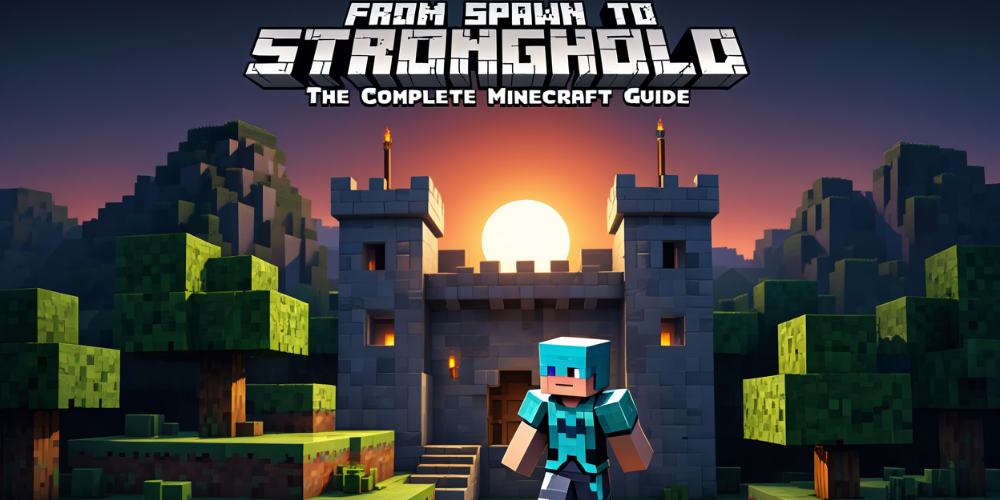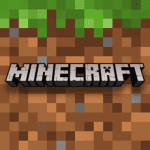From Spawn to Stronghold: The Complete Minecraft Guide
2025-08-25

Ready to turn your first dirt hut into a legendary base and take down the Ender Dragon? This friendly guide gives you a clear, step-by-step path from your first day to late-game power. Simple language, smart tips, and a plan you can follow right now.
Minecraft can feel huge, but it is also very fair. Learn a few core systems, repeat good habits, and you will progress fast. We cover survival basics, building, mining, farming, enchanting, Redstone, the Nether, and bosses. Whether you play Java or Bedrock, solo or with friends, this guide will help you play smarter, not harder.
Pick Your World and Settings
Start with Survival mode on Normal. It is a good balance of challenge and fun. If you want a relaxed start, use Peaceful for a while to test controls and crafting. Keep “Immediate Respawn” off so you learn to protect your base and items.
- Game mode: Survival
- Difficulty: Normal (switch to Easy if you struggle at night)
- World type: Default
- Bonus Chest: On for beginners (gives basic tools and food)
- Coordinates: On (Java: F3; Bedrock: World Settings)
Your First Day: The 10-Minute Plan
Day 1 is about safety and essentials. Punch a tree, craft tools, find food, and make a small shelter before sunset. Avoid caves and fights until you have a shield and stone tools.
- Wood and tools: Punch trees, craft a crafting table, sticks, then a wooden pickaxe. Quickly mine 20 cobblestone to upgrade to stone tools (pickaxe, axe, shovel, sword) and make a furnace.
- Food: Kill a few animals (beef, pork, chicken) or collect apples, berries, or fish. Cook in a furnace if you can.
- Shelter: Dig into a hill or build a 5x5 hut. Place a door, torch, and chest. Use a bed if you found sheep (3 wool + 3 planks).
- Light: Craft torches (coal or charcoal + sticks). Place torches inside and around your shelter.
Charcoal tip: If you cannot find coal, smelt logs into charcoal in a furnace. It works the same as coal for torches and fuel.
Crafting Basics You Will Use All Game
Crafting is your toolkit. Learn these recipes by heart and your progress speeds up.
- Crafting table: 4 planks
- Sticks: 2 planks
- Furnace: 8 cobblestone
- Chest: 8 planks
- Shield: 6 planks + 1 iron ingot (Java) or same in Bedrock; blocks most attacks
- Bucket: 3 iron ingots; very useful for water, lava, and safe falls
- Torch: 1 stick + 1 coal/charcoal
Always craft a shield as soon as you get iron. It is the best early defense against skeletons and creepers.
Mining and Ore Progression
Mine smart, not just deep. Start with a staircase mine at Y-levels that fit the ore you want. Bring food, torches, a water bucket, and spare pickaxes. Keep inventory light to collect more resources.
- Coal and iron: Common near the surface and in caves. Iron unlocks buckets, shields, armor, and shears.
- Copper: Good for building and lightning rods. Not essential for progression.
- Gold and redstone: Found deeper. Gold helps with Nether travel (piglins), redstone powers machines.
- Lapis lazuli: Needed for enchanting.
- Diamonds: Deeper levels. Use an iron pickaxe to mine them.
- Ancient Debris (Netherite): In the Nether; late-game upgrade for diamond gear.
Use branch mining: At your chosen Y-level, dig a main tunnel and small side tunnels every 2 blocks. This exposes many blocks with minimal digging. Water bucket saves you from lava: place water before you step onto unknown blocks.
Food, Farming, and Early Base
Food keeps you alive and speeds healing. Early game, cook meat for strong hunger points. Then move to farms to get a steady, safe supply.
- Starter farm: Wheat (seeds from grass), carrots and potatoes (from villages), beetroot and berries (biomes).
- Tools: Hoe, water bucket, seeds. Place water to hydrate soil (4 blocks radius).
- Animal pens: Fence in cows, sheep, chickens. Breed with wheat (cows, sheep), seeds (chickens).
- Fuel: Use charcoal or coal to cook food.
Create a base near a village, ocean, or plains for resources and space. Place your bed, crafting table, furnace, and chests. Add signs to chests to sort items: stones, ores, wood, food, tools, mob drops, and “adventure kit.” Protect the area with fences and torches to stop mob spawns.
Combat, Armor, and Night Safety
Defense first. A shield plus iron armor makes nights and caves much safer. Learn mob behavior: skeletons use ranged attacks; creepers are silent but slow; spiders climb; endermen are neutral until you look at them.
- Shield up: Right-click/hold to block. Time blocks for skeleton arrows and creeper blasts.
- Weapons: Stone or iron sword; or an axe in Java for strong hits (slower). In Bedrock, sword sweeping is weaker.
- Armor: Aim for full iron quickly; upgrade to diamond, then netherite later.
- Lighting: Place torches every few blocks in caves and around your base.
- Bed: Sleep to skip night. If you cannot, stay underground and mine.
Enchanting: Power Up Your Gear
Enchanting makes tools and armor much better. You need diamonds, obsidian, and a book for an enchanting table. Lapis lazuli is required for enchants. Surround the table with up to 15 bookshelves for max power.
- Best early enchants: Efficiency and Unbreaking on tools; Protection on armor; Sharpness on swords; Power on bows; Fortune or Silk Touch for blocks; Mending from villagers later.
- Grindstone: Remove bad enchants and recover some XP.
- Anvil: Combine items and books. Costs XP, but keeps good enchant lines.
Fish, mine quartz in the Nether, or build a mob farm to get XP quickly for enchanting.
The Nether: Travel, Blaze Rods, and Safety
The Nether is dangerous but key for progression. You need flint and steel and 10 obsidian to build a portal. Place the portal near your base. Before entering, prepare carefully.
- Gear: Full iron or better, shield, bow with arrows, food, blocks, a cauldron with water (Bedrock only) for fire safety, and a gold helmet to stop piglins from attacking.
- Navigation: The Nether compresses distance (1 block in the Nether = 8 in the Overworld). Use coordinates to plan fast travel.
- Targets: Find a Nether fortress for blaze rods and nether wart (for potions). Avoid hoglins and lava lakes.
Blaze rods become blaze powder for brewing stands and for Eyes of Ender. Collect at least 6–8 rods. Grab nether wart from fortress stairs or rooms. Take soul sand for growing wart at home. Consider marking paths with cobblestone and torches so you do not get lost.
Potions: Simple but Strong
Potions can change hard fights into easy wins. Build a brewing stand (blaze rod + cobblestone), add blaze powder as fuel, and use water bottles with nether wart to make awkward potions. Then add specific items:
- Healing: Glistering melon
- Strength: Blaze powder
- Regeneration: Ghast tear
- Swiftness: Sugar
- Fire Resistance: Magma cream (great in the Nether)
- Night Vision: Golden carrot
Use redstone dust to extend duration, and glowstone dust to increase strength. Keep Fire Resistance and Strength before big fights or lava mining.
Villagers and Trading Halls
Villagers are powerful. You can trade for diamond gear, enchanted books, and emeralds. Protect a village with walls and torches. Use beds and workstations to pick professions.
- Librarian: Bookshelf + lectern; gives enchanted books like Mending, Unbreaking, and Protection. You can “reroll” trades by breaking and replacing the lectern before locking a trade.
- Armorer, Weaponsmith, Toolsmith: Can sell high-tier gear.
- Farmer: Good for selling crops for emeralds.
Make an iron farm later using villagers and a zombie to spawn golems. This gives infinite iron for rails, hoppers, and anvils.
Redstone Basics for Everyone
Redstone looks complex, but start small. Learn power, repeaters, and simple circuits. These saves time and effort.
- Doors and traps: Buttons, pressure plates, levers.
- Farms: Auto-sugarcane (observer + piston), pumpkin/melon farms, bone meal loop with composters.
- Storage: Hoppers and chests for sorting and moving items.
- Mob farms: Simple drop farms for gunpowder, bones, and string.
Tip: Test builds in a creative-world copy of your save before you place them in survival.
Exploration and Navigation
The world is big. Use coordinates and simple tools to avoid getting lost.
- Coordinates: Note your base location. Java: F3; Bedrock: enable in settings.
- Maps and compasses: Craft a compass (redstone + iron) and a map with paper. Place banners with names to mark spots (Java feature).
- Boats: Fast and safe ocean travel; bring extra.
- Horses: Quick on land; use leads and fences.
Eyes of Ender and Finding the Stronghold
To reach the End, you need Eyes of Ender (ender pearls + blaze powder). Hunt endermen at night or in the Nether’s Warped Forest. Combine with blaze powder from blazes.
- Throw an Eye of Ender. It floats toward the stronghold. Follow it, collect it if it drops, and repeat every 100–200 blocks.
- When it starts going down, dig carefully with staircases. Light the area. Bring spare blocks and a water bucket.
- In the portal room, place Eyes of Ender in the frame to open the End portal.
Boss Fights: Ender Dragon and Wither
Ender Dragon
Prepare with enchanted diamond gear (Protection, Feather Falling), bow with Power, a pumpkin helmet if endermen bother you, water buckets, slow falling potions if you have phantom membranes, and many blocks.
- Destroy end crystals on obsidian pillars. Use a bow or climb and break them. Iron bars require you to climb and break the cage.
- Attack the dragon when it perches by the portal using a sword or axe. Avoid standing in dragon breath.
- Keep your crosshair low to avoid angering endermen; use water if they attack.
After victory, collect the dragon egg and lots of XP. Use end gateways to find End Cities for elytra (wings) and shulker boxes (portable storage).
Wither
Build the Wither later for a beacon. You need 3 wither skeleton skulls (from Nether fortresses) and soul sand.
- Best fight location: Underground tunnel or a controlled room. In Bedrock, the Wither is harder; prepare strong armor and potions.
- Potions: Strength, Regeneration, and milk buckets to clear Wither effect after the fight.
- Reward: Nether star for a beacon. Place it on a pyramid of iron, gold, emerald, or diamond blocks for powerful buffs.
Elytra, Flight, and Late-Game Travel
With elytra from End Cities, travel becomes easy. Use fireworks to boost speed. Wear unbreaking and mending on elytra. Keep a backup pair at base.
- Landing: Use a water bucket or feather falling boots to avoid damage.
- Maps: Explore biomes and structures fast; mark rare spots (mushroom island, ancient city).
Multiplayer, Performance, and Quality of Life
With friends, roles help: one mines, one farms, one builds. Share gear and plan projects. For performance, lower render distance, reduce particles, and use simple texture packs. Java players can try optimization mods on client-side (like performance-focused ones) if allowed. Back up your world before major builds or dangerous trips, especially in Hardcore on Java.
- Starter kit chest near spawn
- Community farms (iron, food, XP)
- Nether hub for fast travel
Conclusion
Minecraft rewards curiosity and planning. Start safe, get iron, build a farm, then explore deeper systems like enchanting, the Nether, villagers, and Redstone. With these steps, you move from a dirt hut survivor to a confident adventurer who can fly across the world and shape it with clever builds.
- Always carry a shield, food, torches, and a water bucket.
- Note your base coordinates before exploring.
- Enchant early: Efficiency, Unbreaking, and Protection change everything.
- Use the Nether for fast travel and blaze rods; wear some gold.
- Trade with villagers for Mending and gear upgrades.
- Keep spare tools and emergency supplies in a chest at base.
- Practice new Redstone or farm designs in a creative copy first.






